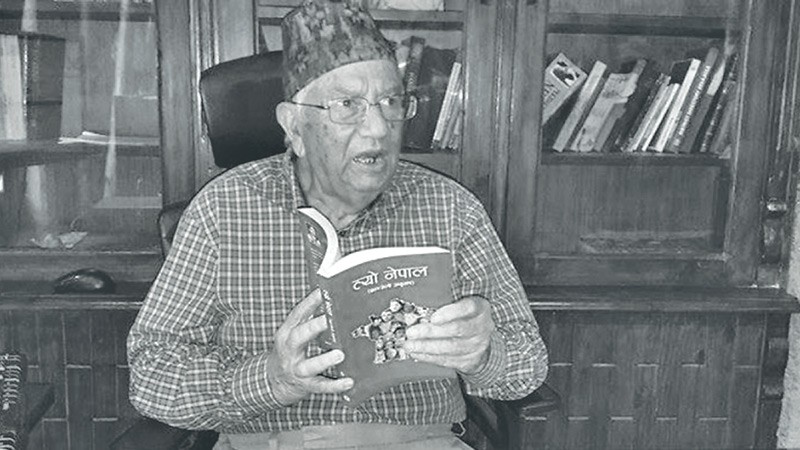Kamal Mani Dixit, a veteran Nepali littérateur and the founder chairman of Madan Puraskar Pustakalaya and Madan Puraskar Guthi, passed away on Thursday morning at his residence in Patan Dhoka, Lalitpur. He was 87.
A statement released by the Pustakalaya confirmed that Dixit breathed his last at 2:45am on Thursday. Family sources said he had been hospitalised for heart and chest-related ailments for three months. He also had pneumonia. His body was cremated at the electric crematorium in Pingalasthan at 7am.
Dixit was born to Kedar Mani Acharya and Bidhya Devi as their second son on August 2, 1929 in Kathmandu. The veteran literary figure penned and edited more than six dozen books and around two thousand literary pieces, mostly in Nepali.
Professor Abhi Subedi calls him a “one man institutionâ€. “I can say it with conviction that he maintained the largest collection of Nepali literary works.â€
Dixit was the one to publish Jang Bahadur Ko Belait-Yatra from the Sajha press. The book has now been of great value for those who look for historical perspectives on the times of the first Rana prime minister.
Dixit took initiatives to establish the Madan Puraskar Pustakalaya and the Madan Puraskar Guthi in 2012 BS (1955) in memory of General Madan Shumsher Jang Bahadur Rana. Since then the Guthi has been providing Madan Puraskar, a prestigious literary award, to the best book in Nepali language and the Jagadamba Shri Puraskar established in 2045BS (1988) in the name of Madan Shumsher’s wife Jagadamba. Cultural expert Satya Mohan Joshi, who is a contemporary of Dixit, calls him a “man born to preserve and promote Nepali literature, its art and historyâ€.
“Every time I talked to him, his talk wouldn’t go away from Nepali literature and he always remained devoted to preserving and promoting it,†said Joshi, adding that Dixit’s contribution to the development of Nepali literature was immense.
“The new generation knows little about Dixit’s works but when they do, they will understand his contribution to the nation,†said Joshi. “He has the best achieve of Nepali literature.â€
Dixit was regarded as a prolific person in many fields. He is also known for his service at the BP Koirala Museum and the Nepal Bharat Pratisthan, besides a number of linguistic, literary and cultural organisations. Dixit became famous in the early stage of his career for his research-based articles. In his late years, he was busy writing memoirs, essays, columns and literary pieces.
Kalo Akshar, Yasto Pani and Sakha Santan are works of research on the Nepali print and publishing history. Jung Gita, Birseko Samjheko, Chandra Jyoti, Saglo Akshar, Bhawadiya Falano are among his published books. Ragataka Kura (Japanese to Nepali), Taro Ra Saathiharu (Japanese to Nepali) and Sanbubakaa Charaharu (Bengali to Nepali) are among his translated works.
Dixit is survived by two sons and a daughter.
By Anup Ojha







